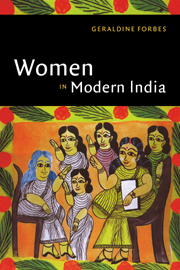Book contents
- Frontmatter
- Introduction
- 1 Reform in the nineteenth century: efforts to modernize women's roles
- 2 Education for women
- 3 The emergence of women's organizations
- 4 The movement for women's rights
- 5 Women in the nationalist movement
- 6 Women's work in colonial India
- 7 A time of transition
- 8 Women in independent India
- Bibliographic essay
- Index
- THE NEW CAMBRIDGE HISTORY OF INDIA
- References
6 - Women's work in colonial India
Published online by Cambridge University Press: 28 March 2008
- Frontmatter
- Introduction
- 1 Reform in the nineteenth century: efforts to modernize women's roles
- 2 Education for women
- 3 The emergence of women's organizations
- 4 The movement for women's rights
- 5 Women in the nationalist movement
- 6 Women's work in colonial India
- 7 A time of transition
- 8 Women in independent India
- Bibliographic essay
- Index
- THE NEW CAMBRIDGE HISTORY OF INDIA
- References
Summary
Dr. Haimabati Sen, a medical doctor in charge of the women's hospital in Chinsurah, described her daily routine in 1895:
I would get up every day at four in the morning, prepare a breakfast for my husband and the children, and go downstairs with hot water and edibles for the patients. I would first help the patients wash… I would finish this chore of helping them wash and give them a piece of batasa or candied sugar as their snack… Where there were children staying with the mother I would make some halua [semolina sweet] and give them small quantities of it. It would take me a little over an hour to attend to the patients and come back. I would go back home, have a wash, wake up the children, dress them, give them breakfast, arrange for my husband's meal, get dressed, have something to eat and then go back to the hospital. This was my daily routine.
The labor of women like Dr. Haimabati Sen, as a medical professional and wife and mother, has largely been hidden from history. Memoirs rarely offer such rich detail about women's work. Unfortunately, our sources on women's work in the nineteenth and even much of the twentieth century are vague and unanalytical. The dearth of reliable data presents a serious challenge for historians attempting to probe the consequences of colonial rule for laboring women.
- Type
- Chapter
- Information
- Women in Modern India , pp. 157 - 188Publisher: Cambridge University PressPrint publication year: 1996

